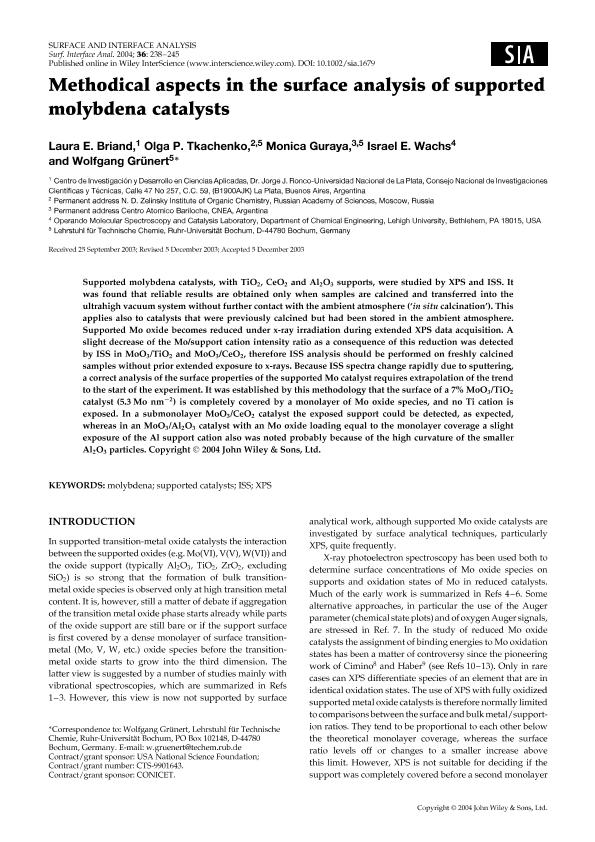Mostrar el registro sencillo del ítem
dc.contributor.author
Briand, Laura Estefania

dc.contributor.author
Tkachenko, Olga P.
dc.contributor.author
Guraya, Monica
dc.contributor.author
Wachs, Israel E.
dc.contributor.author
Grünert, Wolfgang
dc.date.available
2018-10-10T17:52:43Z
dc.date.issued
2004-03
dc.identifier.citation
Briand, Laura Estefania; Tkachenko, Olga P.; Guraya, Monica; Wachs, Israel E.; Grünert, Wolfgang; Methodical aspects in the surface analysis of supported molybdena catalysts; John Wiley & Sons Ltd; Surface and Interface Analysis; 36; 3; 3-2004; 238-245
dc.identifier.issn
0142-2421
dc.identifier.uri
http://hdl.handle.net/11336/62095
dc.description.abstract
Supported molybdena catalysts, with TiO2, CeO2 and Al2O3 supports, were studied by XPS and ISS. It was found that reliable results are obtained only when samples are calcined and transferred into the ultrahigh vacuum system without further contact with the ambient atmosphere ('in situ calcination'). This applies also to catalysts that were previously calcined but had been stored in the ambient atmosphere. Supported Mo oxide becomes reduced under x-ray irradiation during extended XPS data acquisition. A slight decrease of the Mo/support cation intensity ratio as a consequence of this reduction was detected by ISS in MoO3/TiO 2 and MoO3/CeO2, therefore ISS analysis should be performed on freshly calcined samples without prior extended exposure to x-rays. Because ISS spectra change rapidly due to sputtering, a correct analysis of the surface properties of the supported Mo catalyst requires extrapolation of the trend to the start of the experiment. It was established by this methodology that the surface of a 7% MoO3/TiO2 catalyst (5.3 Mo nm-2) is completely covered by a monolayer of Mo oxide species, and no Ti cation is exposed. In a submonolayer MoO3/CeO 2 catalyst the exposed support could be detected, as expected, whereas in an MoO3/Al2O3 catalyst with an Mo oxide loading equal to the monolayer coverage a slight exposure of the Al support cation also was noted probably because of the high curvature of the smaller Al2O3 particles. Copyright © 2004 John Wiley & Sons, Ltd.
dc.format
application/pdf
dc.language.iso
eng
dc.publisher
John Wiley & Sons Ltd

dc.rights
info:eu-repo/semantics/openAccess
dc.rights.uri
https://creativecommons.org/licenses/by-nc-sa/2.5/ar/
dc.subject
Iss
dc.subject
Molybdena
dc.subject
Supported Catalysts
dc.subject
Xps
dc.subject.classification
Otras Ingeniería Química

dc.subject.classification
Ingeniería Química

dc.subject.classification
INGENIERÍAS Y TECNOLOGÍAS

dc.title
Methodical aspects in the surface analysis of supported molybdena catalysts
dc.type
info:eu-repo/semantics/article
dc.type
info:ar-repo/semantics/artículo
dc.type
info:eu-repo/semantics/publishedVersion
dc.date.updated
2018-08-30T15:46:07Z
dc.journal.volume
36
dc.journal.number
3
dc.journal.pagination
238-245
dc.journal.pais
Reino Unido

dc.journal.ciudad
Londres
dc.description.fil
Fil: Briand, Laura Estefania. Consejo Nacional de Investigaciones Científicas y Técnicas. Centro Científico Tecnológico Conicet - La Plata. Centro de Investigación y Desarrollo en Ciencias Aplicadas "Dr. Jorge J. Ronco". Universidad Nacional de la Plata. Facultad de Ciencias Exactas. Centro de Investigación y Desarrollo en Ciencias Aplicadas; Argentina
dc.description.fil
Fil: Tkachenko, Olga P.. Russian Academy of Sciences; Rusia. Ruhr Universität Bochum; Alemania
dc.description.fil
Fil: Guraya, Monica. Comisión Nacional de Energía Atómica. Centro Atómico Bariloche; Argentina
dc.description.fil
Fil: Wachs, Israel E.. Lehigh University; Estados Unidos
dc.description.fil
Fil: Grünert, Wolfgang. Ruhr Universität Bochum; Alemania
dc.journal.title
Surface and Interface Analysis

dc.relation.alternativeid
info:eu-repo/semantics/altIdentifier/doi/https://dx.doi.org/10.1002/sia.1679
dc.relation.alternativeid
info:eu-repo/semantics/altIdentifier/url/https://onlinelibrary.wiley.com/doi/abs/10.1002/sia.1679
Archivos asociados
